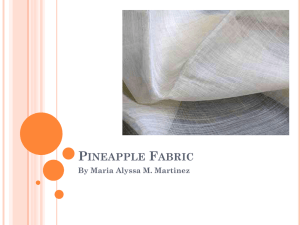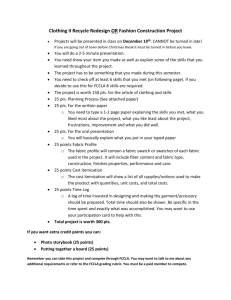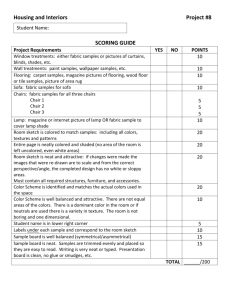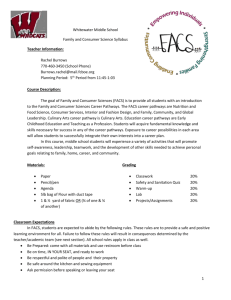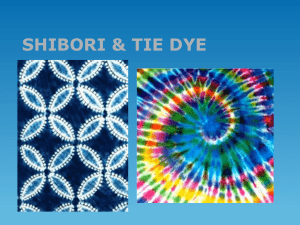- Glacier Journal
advertisement
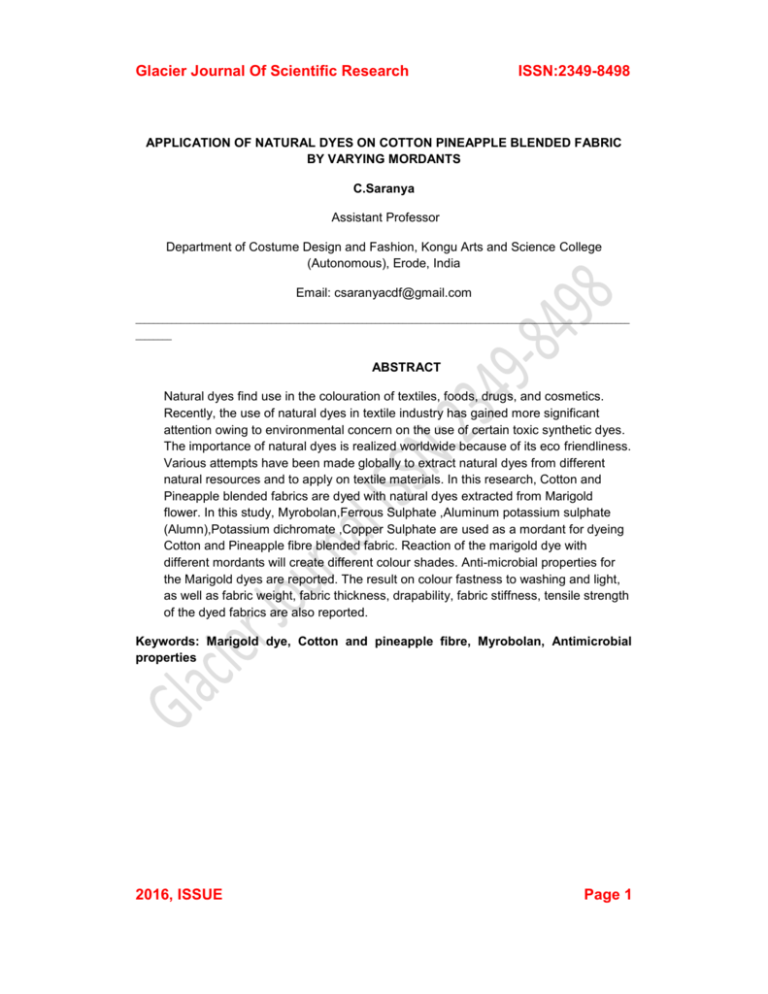
Glacier Journal Of Scientific Research ISSN:2349-8498 APPLICATION OF NATURAL DYES ON COTTON PINEAPPLE BLENDED FABRIC BY VARYING MORDANTS C.Saranya Assistant Professor Department of Costume Design and Fashion, Kongu Arts and Science College (Autonomous), Erode, India Email: csaranyacdf@gmail.com _____________________________________________________________________________________________________________ ________ ABSTRACT Natural dyes find use in the colouration of textiles, foods, drugs, and cosmetics. Recently, the use of natural dyes in textile industry has gained more significant attention owing to environmental concern on the use of certain toxic synthetic dyes. The importance of natural dyes is realized worldwide because of its eco friendliness. Various attempts have been made globally to extract natural dyes from different natural resources and to apply on textile materials. In this research, Cotton and Pineapple blended fabrics are dyed with natural dyes extracted from Marigold flower. In this study, Myrobolan,Ferrous Sulphate ,Aluminum potassium sulphate (Alumn),Potassium dichromate ,Copper Sulphate are used as a mordant for dyeing Cotton and Pineapple fibre blended fabric. Reaction of the marigold dye with different mordants will create different colour shades. Anti-microbial properties for the Marigold dyes are reported. The result on colour fastness to washing and light, as well as fabric weight, fabric thickness, drapability, fabric stiffness, tensile strength of the dyed fabrics are also reported. Keywords: Marigold dye, Cotton and pineapple fibre, Myrobolan, Antimicrobial properties 2016, ISSUE Page 1 Glacier Journal Of Scientific Research ISSN:2349-8498 INTRODUCTION Textiles have such an important bearing on our daily lives that everyone need to know something above them from earliest times .Pineapple fiber yarn is extracted from the pineapple plant. Extraction of fibers means separation of fibers from the commenting subtonics such as pectin’s or lignin’s wax resins, fats and other carbohydrates, fibers from vegetable plants are extracted by mechanical retting.The leaves of pineapple plant contain approximately 3% of strong white silky fibers .The extracted fiber is knotted by hands and made into yarn. Pineapple fiber yarn gives luster as like silk. It is little course fiber then silk. Cotton is an element which transforms the entire life of fabric. Cotton is a soft fluffy stable fiber . The fiber is almost pure cellulose the botanical purpose of cotton fiber is to aid in seed dispersal. Natural dyes are safer, easy disposal, eco friendliness and some dyes have medicinal properties that will improve value addition to the product. Marigold plant is a stout branching herb, very popular as a garden as a garden plant for us bright coloured flowers. The flowers are lemon yellow or orange in colour. The flower heads yield a shinning yellow dye flowers bloom abundantly from the beginning of summer upto autumn and even faded flowers are rich in dyeing pigment. Marigold dye can range is colour from a brilliant, sunny yellow to a deep crimson, depending on the colour of the flower. Marigold has anti-septic, and anti-fungal properties.In this study, cotton and pineapple blended yarn is converted into plain woven eco-friendly fabric dyed with natural dyes. OBJECTIVES OF THE STUDY To extract the pineapple fiber from the leaf of the pineapple plant. To blend cotton and pineapple fiber into 40s count yarn. To weave the pineapple fiber and cotton blended yarn with plain weave. To treat the fabric with different mordants. To dye the above fabric using natural Marigold flower dye. To test the dyed fabrics for the required qualities . MATERIALS AND METHODS SELECTION OF YARN 75% pineapple fibre + 25% cotton blended yarn 2016, ISSUE Page 2 Glacier Journal Of Scientific Research ISSN:2349-8498 SELECTION OF COUNT 40 s count SELECTION OF WEAVE Plain weave PREPARATION OF FABRIC FOR DYEING SCOURING Pineapple and cotton blended fabric is washed in a solution containing 0.5gk sodium carbonate and 2gk nonionic detergent solution at 50oC for 25 min keeping the material is to liquor ratio at 1:40. The scoured material is thoroughly washed with water and dried at room temperature. The scoured materials are soaked in clean water for 30 min prior to dyeing or mordanting SELECTION OF MORDANT Myrobolan Ferrous Sulphate Aluminum potassium sulphate (Alum) Potassium dichromate Copper Sulphate MORDANTING Accurately weighed cotton and pineapple fibre blended fabric sampleis treatedwith different mordants-Myrobolan (PC1 ), Ferrous Sulphate (PC2 ), Alum (PC3), Potassium dichromate (PC4 )& Copper Sulphate (PC5 ). The scoured fabric is then subjected to heating. Temperature of the dye bath is raised to 80oC over a period of half an hour and left for another 30 minutes. The materials are then rinsed with water thoroughly, squeezed and dried. Finally the fabrics are subjected to dyeing because mordant is very sensitive to light. SELECTION OF DYE Marigold Dye PREPARATION OF MARIGOLD DYE EXTRACT The fresh petals of Marigold are shadow dried and made into a fine powder. Dry powder is then mixed with 99.9% absolute ethanol in the ratio of 1:5 in a beaker. The beaker is placed in the shaker and allowed overnight to 40oC so that the ethanol takes in the active components of the petals. Then the solution is centrifuged and filtered using filter paper. The clear solution is powder onto the petri plates and placed in the hot air 2016, ISSUE Page 3 Glacier Journal Of Scientific Research ISSN:2349-8498 oven set at 80oC and ethanol is allowed to evaporate for 1 hour. Now the marigold due is extracted and ready to use it for dyeing. METHOD OF APPLICATION Dip dyeing method NOMENCLATURE OF THE SAMPLES S.No SAMPLE CODE YARN USED 1 PC1 Myrobolan 2 PC2 Ferrous Sulphate 3 PC3 Aluminum potassium sulphate (Alum) 75% pineapple + 25% cotton blended yarn WEAVE MORDANT USED Plain weave 4 PC4 Potassium dichromate 5 PC5 Copper Sulphate RESULTS& DISCUSSION Physical tests Fabric Weight It is evident that there is a slight difference in fabric weight of the dyed samplescompared to original sample. Sample (PC2) showed maximum weight compared to other samples. Fabric Thickness 2016, ISSUE Page 4 DYE USED Marigold Dye Glacier Journal Of Scientific Research ISSN:2349-8498 It is found that the fabric thickness of the sample (PC3) has slight increase compare to the others. Tensile strength It is evident that the tensile strength is more in sample (PC2) and sample (PC4) in warp and weft direction respectively. Stiffness test It is found that bending length in the warp way direction is high in sample (PC5) , in weft way direction the bending length is high in sample (PC3). Fabric Drape It is revealed that the drapability of pineapple cotton fabric dyed with marigold dye is good . Colour fastness test Colour Fastness to Light&washing Colour fastness to light and washing is very good in Sample PC4 Antimicrobial test: Mycelia growth test It is found that there is a reduction in the growth of mycelia (fungus) in all the treated samples when compared to untreated fabric samples. The 100% treated sample shows maximum anti microbial activity than others. FABRIC WEIGHT Table – I S. No Sample PC in GSM 1 PC1 80 2 PC2 82 3 PC3 77 4 PC4 70 5 PC5 78 FIGURE – I 2016, ISSUE Page 5 Glacier Journal Of Scientific Research 84 82 ISSN:2349-8498 82 80 80 78 77 78 76 74 72 70 70 68 66 64 PC1 PC2 PC3 PC4 PC5 FABRIC THICKNESS Table - II S. No 1 2 3 4 5 Sample PC1 PC2 PC3 PC4 PC5 PC in mm 15 13 16 15 14 FIGURE - II 2016, ISSUE Page 6 Glacier Journal Of Scientific Research 18 16 15 16 ISSN:2349-8498 15 14 13 14 12 10 8 6 4 2 0 PC1 PC2 PC3 PC4 PC5 TENSILE STRENGTH Table III S. No 1 2016, ISSUE Sample PC1 WARP WAY Tensile Strength In 1bs 70 WEFT WAY Elongation in Inch 2.5 Tensile Strength In 1bs 50 Elongation in Inch 2.1 Page 7 Glacier Journal Of Scientific Research 2 3 4 5 PC2 PC3 PC4 PC5 ISSN:2349-8498 80 60 75 50 2.9 2.7 2.6 2.2 60 55 65 45 2.3 2.2 2.5 1.8 FIGURE - III TENSILE STRENGTH BREAKING LOAD 90 80 80 75 70 70 60 60 65 60 55 50 50 45 50 WARP WEFT 40 30 20 10 0 PC1 PC2 PC3 PC4 PC5 TENSILE STRENGTH ELONGATION 3.5 2.9 3 2.7 2.6 2.5 2.5 2.3 2.1 2.5 2.2 2.2 2 1.8 WARP WEFT 1.5 1 0.5 0 PC1 2016, ISSUE PC2 PC3 PC4 PC5 Page 8 Glacier Journal Of Scientific Research ISSN:2349-8498 FABRIC STIFFNESS Table VI S.No Sample Stiffness in warp direction Stiffness direction Bending length in (Cms) Bending length in (Cms) 1 PC1 3.2 2.6 2 PC2 3.1 2.5 3 PC3 3.2 2.7 4 PC4 3.3 2.6 5 PC5 3.4 2.5 in weft FIGURE – IV 4 3.5 3.2 3 2.6 3.4 3.3 3.2 3.1 2.7 2.5 2.6 2.5 2.5 WARP 2 WEFT 1.5 1 0.5 0 PC1 2016, ISSUE PC2 PC3 PC4 PC5 Page 9 Glacier Journal Of Scientific Research ISSN:2349-8498 FABRIC DRAPE Table V S.No Sample Drapability of PC fabric in percentage 1 PC1 24.7 2 PC2 25.3 3 PC3 25.8 4 PC4 24.9 5 PC5 26.1 FIGURE – V FABRIC DRAPE 26.5 26.1 26 25.8 25.5 25.3 24.9 25 24.7 24.5 24 PC1 2016, ISSUE PC2 PC3 PC4 PC5 Page 10 Glacier Journal Of Scientific Research ISSN:2349-8498 COLOUR FASTNESS TEST TABLE - VI S. No SAMPLE COLOUR FASTNESS TO LIGHT After 5 Hrs 1 2 3 4 5 PC1 PC2 PC3 PC4 PC5 COLOUR FASTNESS TO WASHING After 10 Hrs Change in colour Staining on sample ¾ 3 3 ¾ 4 4 4 ¾ ¾ 3 3 ¾ 4/5 4 4 4/5 3 3 3 3 1. Very poor , 2.Poor , 3. Mordent , ¾ Fair , 4. Good , 4/5 Very Good , 5. Excellent CONCLUSION The investigator has given a conclusion that the pineapple filament is strong when it is blended with cotton .The fabric is pre-treated with different Mordants.then the fabric is dyed with Marigold dye. Reaction of Marigold dye with different mordantscan produce different shades. Marigold dye can control the growth of microbes. The combination of pineapple cotton blended fabric with marigold dye with different mordant has antimicrobial property and it is a ecofriendly fabric. REFERENCES Textile Dyer & Printer, 1996, 29, October Paul R. MalankerJ.V and Naik P. 16-24 Indian Journal of Fiber & Textile Research, 2006, 31,December 583- 587 Li.W. and X.W, P. 219 Mahale G , Sunanda R K and Sakshi ,C olour fastness of eco dyed cotton with Marigold ,Text trends, 2000, P. 35-39 2016, ISSUE Page 11 Glacier Journal Of Scientific Research 2016, ISSUE ISSN:2349-8498 Page 12 Glacier Journal Of Scientific Research 2016, ISSUE ISSN:2349-8498 Page 13


